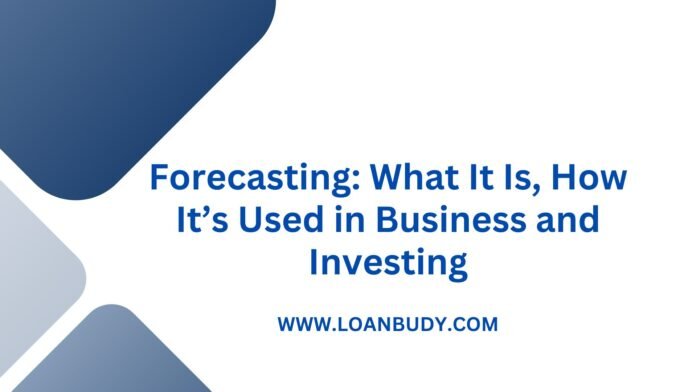In an ever-evolving world, the ability to predict future trends and outcomes is invaluable. Whether you’re a business owner looking to navigate market shifts or an investor aiming to optimize returns, forecasting plays a crucial role in strategic planning and decision-making. In this blog post, we’ll explore what forecasting is, its importance, and how it’s used in both business and investing.
What Is Forecasting?
Forecasting is the process of estimating future trends, outcomes, or conditions based on historical data, current information, and statistical methods. It involves using various tools and techniques to predict what is likely to happen in the future. Forecasting can apply to a wide range of fields, including finance, economics, marketing, and operations.
Types of Forecasting
- Quantitative Forecasting: This approach relies on numerical data and statistical methods to predict future events. Common techniques include:
- Time Series Analysis: Analyzing historical data points to identify trends, seasonal patterns, and cyclical movements.
- Regression Analysis: Using statistical models to understand the relationship between variables and predict future values.
- Qualitative Forecasting: This approach is based on subjective judgment, intuition, and expertise. It is often used when historical data is limited or non-existent. Techniques include:
- Expert Judgment: Consulting industry experts or experienced professionals to make predictions based on their knowledge.
- Delphi Method: Gathering insights from a panel of experts through iterative rounds of questioning and feedback.
How Forecasting is Used in Business
Forecasting is a vital tool for businesses, helping them make informed decisions and plan for the future. Here are some key areas where forecasting is applied:
1. Financial Planning
Businesses use forecasting to estimate future revenue, expenses, and profitability. Financial forecasts help companies create budgets, set financial goals, and plan for cash flow needs. Accurate financial forecasting allows businesses to allocate resources efficiently and prepare for potential financial challenges.
2. Demand Planning
Accurate demand forecasting enables businesses to predict customer demand for products or services. This helps in inventory management, production planning, and supply chain optimization. By understanding future demand, companies can avoid overstocking or stockouts and ensure they meet customer needs effectively.
3. Market Analysis
Businesses use forecasting to analyze market trends and predict future market conditions. This includes assessing the impact of economic factors, competitive dynamics, and consumer behavior. Market forecasts help companies identify growth opportunities, develop marketing strategies, and stay ahead of industry trends.
4. Strategic Planning
Long-term strategic planning relies on forecasting to set goals and develop strategies for growth and expansion. Businesses use forecasts to evaluate potential risks and opportunities, plan for new product launches, and enter new markets.
How Forecasting is Used in Investing
For investors, forecasting is crucial in making informed investment decisions and managing risk. Here’s how forecasting is applied in investing:
1. Stock Market Predictions
Investors use forecasting techniques to predict future stock prices and market trends. This involves analyzing financial statements, market conditions, and economic indicators. Technical analysis, which examines historical price data and trading volumes, is another common method for forecasting stock movements.
2. Economic Forecasting
Economic forecasts help investors understand the broader economic environment and its impact on investments. Factors such as GDP growth, inflation rates, and interest rates can influence investment returns. By staying informed about economic forecasts, investors can adjust their portfolios to align with anticipated economic conditions.
3. Risk Management
Forecasting is essential for managing investment risk. By predicting potential market fluctuations and assessing the likelihood of various scenarios, investors can develop strategies to mitigate risk. This includes diversifying investments, setting stop-loss orders, and adjusting asset allocations based on forecasted market conditions.
4. Portfolio Optimization
Investors use forecasting to optimize their investment portfolios by estimating future returns and assessing the risk associated with different assets. Forecasts help in making decisions about asset allocation, selecting investment opportunities, and balancing risk and reward.
Challenges in Forecasting
While forecasting is a powerful tool, it comes with challenges:
- Data Limitations: Forecasting relies on historical data, which may not always be a reliable indicator of future trends, especially in rapidly changing environments.
- Uncertainty: Forecasts are inherently uncertain, and unexpected events or changes in market conditions can impact their accuracy.
- Complexity: Advanced forecasting methods require sophisticated models and expertise, making them complex to implement and interpret.
Conclusion
Forecasting is an essential practice for both businesses and investors, providing valuable insights into future trends and helping to inform strategic decisions. By understanding and applying forecasting techniques, organizations can plan more effectively, manage risks, and seize opportunities. Whether you’re looking to optimize your business operations or make informed investment choices, mastering the art of forecasting can be a game-changer in achieving your goals.
We hope this blog post has provided a clear overview of forecasting and its significance. Feel free to share this with others who might find it useful, and don’t hesitate to reach out with any questions or thoughts on this topic!
Read More:
- Understanding Earnings Per Share (EPS): What It Means and How to Calculate It
- Understanding IPOs: How Initial Public Offerings Work
- Understanding the Internal Revenue Service (IRS): A Comprehensive Guide












